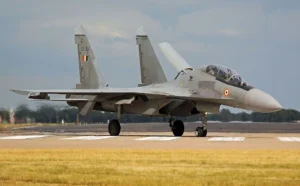The NASM-SR and LRASM can uplift India’s deterrence and naval capabilities to do damage with lighter, more agile weapons that can be fired by helicopters and small warships
The missile, developed by the Defence Research and Development Organisation, is still in the initial stages of development and the Indian Navy’s warships will be equipped with it within seven years.
India is gearing up for the inaugural test of a much-anticipated long-range anti-ship missile (LRASM). The trial is set to occur in the early part of October — between October 5 and 9 — from Abdul Kalam Island situated off the coast of Odisha in the Bay of Bengal.
According to reports, the missile is likely to have a range of 500 kilometres which is greater than the range of 350-400 kilometres offered by the supersonic Indo-Russian cruise missile BrahMos. The missile, developed by the Defence Research and Development Organisation (DRDO) is still in the initial stages of development and the Indian Navy’s warships will be equipped with it within seven years.
This missile shows significant potential for enhancing the Navy’s capabilities, especially in the realm of ship-based missile systems with extended range.
In May 2022, India tested its first indigenously built anti-ship missile falling in the short-range category weighing around 380 kilograms with a range of 55 kilometres. The ‘Naval Anti-ship Missile-short range’ (NASM-SR) can be launched from attack helicopters.
Although the supersonic BrahMos missile continues to serve as the Indian Navy’s primary anti-ship weapon, its weight, exceeding 2 tonnes, presents a significant limitation. Despite ongoing collaborative efforts between India and Russia to create a lighter version of the BrahMos suitable for fighter jets, the missile would remain impractical for deployment on helicopters or smaller vessels.
Eye On China
This where the NASM-SR and LRASM can uplift India’s deterrence and naval capabilities to do damage with lighter, more agile weapons that can be fired by helicopters and small warships.
The lesson from the sinking of the Russian warship Moskva in the Black Sea and the loss of British warships during the Falklands War of 1982 is that modern naval vessels typically store considerable quantities of flammable materials, which include fuel, wiring, weaponry, electronics, and other components. These materials can potentially amplify the destructive impact of relatively small anti-ship missiles.
With the number of Chinese spy ships in the Indian Ocean rising, India is racing to fill its naval stockpiles. Therefore, an enhanced inventory of such indigenously built anti-ship missiles shall significantly raise India’s firepower against China’s expanding naval fleet and Pakistan’s navy, which is also moving to replenish its fleet.
India’s Missile Prowess
India’s missile technology has evolved to be one of the most advanced in the world, next to the USA, Russia, China and France. From the nuclear-capable Agni series to missiles that can take down satellites in space, India has developed a range of deadly indigenous missiles across various categories, including ballistic missiles, cruise missiles, and anti-aircraft missiles.
India has developed powerful ballistic missiles like the Agni series, which can carry nuclear warheads over various distances. The Agni-V, with a range of over 5,000 kilometers, shows India’s ability to target far-off places accurately.
India has also made the BrahMos cruise missile in partnership with Russia. It’s known for its accuracy and works well on naval ships and aircraft.
India is working on anti-missile systems like the Prithvi Air Defence (PAD) and Advanced Air Defence (AAD) systems, which are designed to stop incoming ballistic missiles.
India’s missile capabilities extend to space, with successful tests of anti-satellite (ASAT) missiles that can destroy satellites in low Earth orbit.
These missiles are crucial for India’s national security and deterrence strategy, which aims to protect the country and maintain stability in the region.
Indian Missiles In Demand In The Indo-Pacific
Over the years, India’s newest anti-ship missiles may compliment its catalogue of defence exports.
India has remained focused on enhancing its capabilities and expanding its missile inventory, its missile technology has garnered international attention reflecting India’s export potential.
More than a dozen friendly nations in West Asia, Africa and Southeast Asia have expressed interest in buying the supersonic BrahMos missile which is the flagship showpiece of India’s defence exports. In fact, India has found pivotal success in its Indo-Pacific neighbourhood as a major defence exporter.
Southeast Asian nations find it increasingly important to engage with India amid heightened hostility and haughtiness from China. Unlike China, India shares a relationship of mutual respect with these nations. Moreover, directly owing to the threat emanating from Beijing, India’s defence relations and military exports to the region are catching speed.
While India weighs modestly in the defence exports market, it is making efforts to turn this image around to become a notable defence exporter, and ASEAN is a market where India expects significant breakthroughs. The Philippines has already signed up for the BrahMos missile, the fastest cruise missile in the world, in a deal worth $375 million. Vietnam and Indonesia are next in line with major orders expected to be just around the corner.
The Future of BrahMos
India is actively engaged in extending the range of the BrahMos missile from its current range of 350-400 kilometers to an impressive 800 kilometers. The Indo-Russian supersonic anti-ship cruise missile, initially tested in 2001, has undergone numerous trials and has been integrated into all three branches of the Indian military.
This missile holds the distinction of being the world’s fastest cruise missile, capable of deployment via land, air, and sea platforms. While the precise number of BrahMos missiles in the Indian Armed Forces’ arsenal remains undisclosed, it is estimated that their combined inventory may comprise over 1,200 to 1,500 BrahMos missiles.
Additionally, there is an ongoing development effort for a lighter variant of the air-launched BrahMos-A missile, known as the BrahMos-NG, which is intended for use by the Indian Air Force.
Source link







